Ozito PXBC-6080 Handleiding
Ozito
Niet gecategoriseerd
PXBC-6080
Bekijk gratis de handleiding van Ozito PXBC-6080 (4 pagina’s), behorend tot de categorie Niet gecategoriseerd. Deze gids werd als nuttig beoordeeld door 65 mensen en kreeg gemiddeld 4.5 sterren uit 33 reviews. Heb je een vraag over Ozito PXBC-6080 of wil je andere gebruikers van dit product iets vragen? Stel een vraag
Pagina 1/4

CARING FOR THE ENVIRONMENT
Power tools that are no longer usable should not be disposed of with
household waste but in an environmentally friendly way. Please recycle
where facilities exist. Check with your local council authority for
recycling advice.
Recycling packaging reduces the need for landll and raw materials.
Reuse of recycled material decreases pollution in the environment.
Please recycle packaging where facilities exist. Check with your local
council authority for recycling advice.
DESCRIPTION OF SYMBOLS
Warning
Do not store or use battery in
temperatures exceeding 50 C°
Volts Hertz
Alternating Current
Direct Current
Milliamperes
Watts
Amp Hour
Ah
W
HzV
ac/~
mA
Lithium Ion Battery
Do not put in the rubbish
Do not get battery wet
Recycle Battery
Do not incinerate
dc
Regulatory Compliance
Mark (RCM)
Do not store battery when the charge
is low; store between 40-60%.
40-60%
0%
4.0Ah BATTERY
INSTRUCTION MANUAL
PXBP-400
SPECIFICATIONS
Input: 18V
Battery Capacity: 4.0Ah Li-ion
Power Consumption: 72Wh
Weight: 0.65kg
2
1. Battery
2. Battery Release Button
3. Charge Indicator Button
ozito.com.au
31
Before using the charger or battery read all instructions and cautionary markings on the charger, battery pack and the
product using the battery pack. Do not lose these safety instructions.
Battery Warnings
1. The battery pack is not fully charged out of the carton. First read the safety instructions and then follow the charging
notes and procedures.
2. For optimum battery performance avoid low discharge cycles. Charge the battery pack frequently.
3. Use and store the battery pack in dry conditions with low humidity between 0-50°C, ideally at 15°C. Avoid exposing
battery pack and charger to direct sunlight.
4. Do not keep battery pack in places where temperatures are liable to reach over 50°C, such as in a car, metal shed or
similar that is in direct sunlight.
5. Do not ignite the battery pack or expose it to re. There is a risk of explosion!
6. Do not exhaustively discharge batteries. Exhaustive discharge will damage the battery cells. The most common
cause of exhaustive discharge is long-term storage and continued use of low-charge batteries. Always store the
battery with some charge. Charge the batteries every 2-3 months to restore charge. Stop working as soon as the
performance of the battery falls noticeably or the electronic protection system triggers.
7. Protect batteries and the tool from overloads. Overloads will quickly result in overheating and cell damage inside
the battery housing without this overheating being apparent externally.
8. Avoid damage and shocks. Do not use batteries which have been dropped from a height of more than one meter or
strong external impact, even if the housing of the battery pack appears to be undamaged. The battery cells inside
the battery may have suffered serious damage.
9. If the battery pack suffers overloading and overheating, the integrated protective cut-off will switch off the equip-
ment. Do not press the ON/OFF switch on the tool if the protective cut-off has actuated. This may damage the
battery pack. Allow the battery to cool to room temperature before use.
10. Use only original battery packs. The use of other batteries may result in injuries, explosion and a re risk.
11. Protect your rechargeable battery against moisture, rain and high humidity. Moisture, rain and high humidity can
cause dangerous cell damage. Never charge or use batteries which have been exposed to moisture, rain or high
humidity.
12. Never attempt to open the battery pack for any reason. If the plastic housing of the battery pack is damaged, do not
use the battery.
13. When battery pack is not in use, keep it away from other metal objects, like paper clips, coins, keys, nails, screws or
other small metal objects, that can make a connection from one terminal to another. Shorting the battery terminals
together may cause burns or a re.
14. Under abusive conditions, liquid may be ejected from the battery; avoid contact. If accidental contact occurs, ush
with water and seek medical help immediately. Liquid ejected from the battery may cause irritation or burns.
15. Do not use a battery pack or tool that is damaged or modied. Damaged or modied batteries may exhibit unpredict-
able behaviour resulting in re, explosion or risk of injury.
16. Do not expose a battery pack or tool to re or excessive temperature. Exposure to re or temperature above 130°C
may cause explosion.
17. Never service damaged battery packs. Service of battery packs should only be performed by the manufacturer.
18. 18. Do not disassemble Battery. This may result in a risk of electric shock, electrocution or re.
Charger Warnings
19. Please check the data marked on the rating plate of the battery charger. Ensure to only connect the battery charger
to a power supply with the voltage marked on the rating plate.
20. Protect the battery charger and its cable from damage and sharp edges. Have damaged cables repaired by an
authorised service agent before use.
21. Keep the battery charger, batteries and the cordless tool out of children’s reach.
22. Do not use damaged battery chargers.
23. Do not use the supplied battery charger to charge other cordless tools. Only charge Ozito Power X Change
rechargeable batteries with an Ozito Power X Change Charger.
24. The battery pack may become warm during use. Allow the battery pack to cool to room temperature before
commencing with the charging.
25. Do not over-charge batteries. Do not exceed the maximum charging times. These charging times only apply to
discharged batteries. Frequent insertion of a charged or partly charged battery pack will result in over-charging and
cell damage. Do not leave fully charged batteries in the charger.
26. Charge the battery pack in dry conditions with low humidity between 10-40°C. Avoid exposing battery pack and
charger to direct sunlight.
27. Do not use batteries which have suffered deformation during the charging process or shows any other signs of
abnormalities including, excessive curvature of the housing, gassing, hissing or cracking.
28. Never fully discharge the battery pack. A complete discharge of the battery pack will lead to premature ageing of
the battery cells.
29. Never charge the batteries unsupervised.
30. Do not cover or place any object on top of the charger, place the charger away from heat sources.
31. To reduce risk of damage to the electric plug and cord, pull by the plug rather than the cord when disconnecting the
charger.
32. Make sure the cord is located so that it will not be stepped on, tripped over, or otherwise subjected to damage or
stress.
33. An extension cord should not be used unless necessary. Use of an improper extension cord could result in the risk of
re, electric shock or electrocution.
34. Do not disassemble charger. This may result in a risk of electric shock, electrocution or re.
35. To reduce risk of electric shock, unplug the charger from the outlet before attempting any cleaning. Removing the
battery pack will not reduce this risk.
36. Do not use the cordless tool or the battery charger near vapours and inammable liquids.
BATTERY & CHARGER SAFETY WARNINGS
ELECTRICAL SAFETY
When using mains-powered tools, basic safety precautions, including the following, should WARNING!
always be followed to reduce risk of re, electric shock, personal injury and material damage.
Read the whole manual carefully and make sure you know how to switch the tool off in an emergency, before
operating the tool. Save these instructions and other documents supplied with this tool for future reference.
Note: The supply of 230V and 240V on Ozito tools are interchangeable for Australia and New Zealand.
If the supply cord is damaged, it must be replaced by the manufacturer, its service agent or similarly qualied persons in
order to avoid hazard.
Note: Double insulation does not take the place of normal safety precautions when operating this tool. The insulation
system is for added protection against injury resulting from a possible electrical insulation failure within the tool.
Using an Extension Lead
Always use an approved extension lead suitable for the power input of this tool. Before use, inspect the extension lead for
signs of damage, wear and ageing. Replace the extension lead if damaged or defective.
When using an extension lead on a reel, always unwind the lead completely. Use of an extension lead not suitable for the
power input of the tool or which is damaged or defective may result in a risk of re and electric shock.
To reduce the risk of electric shock, we recommend the use of a residual current device (rated 30mA or less).
This appliance is not intended for use by persons (including children) with reduced physical, sensory or mental
capabilities, or lack of experience and knowledge, unless they have been given supervision or instruction concerning use
of the appliance by a person responsible for their safety.
Children should be supervised to ensure that they do not play with the appliance.

BATTERY CHARGE INDICATOR
The purchased battery is equipped with a
battery charge indicator to show the state of
the battery charge.
Press the charge indicator button and look to
see which LED lights.
Battery requires immediate charging
Low state of charge, requires charging soon.
Mid state of charge
Full state of charge.
Note: The battery needs to be removed from the tool to check the state of charge.
BATTERY PROTECTION SYSTEM
The tool is equipped with a battery protection system, which helps to ensure longevity
of the battery.
The output power automatically cuts off during operation when the tool and/or battery
are placed under the following situations:
• When the tool is overloaded:
If this occurs, release the trigger switch and remove causes of overload, then pull
the switch trigger again to restart.
• When the remaining battery capacity becomes low:
Recharge the battery pack.
Note: The battery protection system does not in any way damage the tool.
Note: The indicated capacity may be lower than the actual level during use or
immediately after using the tool.
WARRANTY
IN ORDER TO MAKE A CLAIM UNDER THIS WARRANTY YOU
MUST RETURN THE PRODUCT TO YOUR NEAREST BUNNINGS
WAREHOUSE WITH YOUR BUNNINGS REGISTER RECEIPT. PRIOR TO
RETURNING YOUR PRODUCT FOR WARRANTY PLEASE TELEPHONE
OUR CUSTOMER SERVICE HELPLINE:
Australia 1800 069 486
New Zealand 0508 069 486
TO ENSURE A SPEEDY RESPONSE PLEASE HAVE THE MODEL
NUMBER AND DATE OF PURCHASE AVAILABLE. A CUSTOMER
SERVICE REPRESENTATIVE WILL TAKE YOUR CALL AND
ANSWER ANY QUESTIONS YOU MAY HAVE RELATING TO THE
WARRANTY POLICY OR PROCEDURE.
The benets provided under this warranty are in addition to other rights and
remedies which are available to you at law.
Our goods come with guarantees that cannot be excluded at law. You are
entitled to a replacement or refund for a major failure and for compensation
for any other reasonably foreseeable loss or damage. You are also entitled to
have the goods repaired or replaced if the goods fail to be of acceptable
quality and the failure does not amount to a major failure.
Generally you will be responsible for all costs associated with a claim under
this warranty, however, where you have suffered any additional direct loss as
a result of a defective product you may be able to claim such expenses by
contacting our customer service helpline above.
36 MONTH REPLACEMENT WARRANTY
Your product is guaranteed for a period of 36 months from the original date
of purchase and is intended for DIY (Do It Yourself) use only. If a product is
defective it will be replaced in accordance with the terms of this warranty.
Warranty excludes consumable parts.
WARNING
The following actions will result in the warranty being void.
• If the tool has been operated on a supply voltage other than that specied
on the tool.
• If the tool shows signs of damage or defects caused by or resulting from
abuse, accidents or alterations.
• Failure to perform maintenance as set out within the instruction manual.
• If the tool is disassembled or tampered with in any way.
OZITO Australia/New Zealand (Head Ofce)
25 Fox Drive, Dandenong South, Victoria, Australia 3175.
ONLINE MANUAL
Scan this QR Code with your
mobile device to take you to the
online manual.
PXBP-400
1. OPERATION
CHARGING YOUR LITHIUM ION BATTERY
This battery has been shipped in a low charge condition, and requires charging prior to
use. Allow several cycles of charging and discharging (through use with a compatible
tool) for the battery to reach its optimum performance / runtime.
This battery is compatible with chargers from the 18V Ozito Power X Change range
available through your local Bunnings Warehouse. Product availability may differ.
Only use the battery pack with Ozito Power X Change 18V cordless products.
1. Insert the power plug of the charger into the mains socket outlet. The green LED
will begin to ash when properly connected to power supply.
2. Insert the battery pack into the battery charger .
3. Remove battery from the charger once fully charged. Disconnect the charger from
the power supply.
Note: The battery pack can become a little warm during the charging. This is normal.
If the battery pack fails to charge, check:
if there is voltage at the socket outlet
that the battery and charger are properly connected.
If the battery pack still fails to charge, please contact our customer service center.
0121

CARING FOR THE ENVIRONMENT
Power tools that are no longer usable should not be disposed of with household
waste but in an environmentally friendly way. Please recycle where facilities exist.
Check with your local council authority for recycling advice.
Recycling packaging reduces the need for landll and raw materials. Reuse of
recycled material decreases pollution in the environment. Please recycle packaging
where facilities exist. Check with your local council authority for recycling advice.
DESCRIPTION OF SYMBOLS
2
1. Charging Unit
2. Charging Unit LED
ozito.com.au
1
COMPACT
FAST CHARGER
INSTRUCTION MANUAL
PXCG-030C
SPECIFICATIONS
Input: 200-250V ~AC 50-60Hz, 72W
Output: 20V DC, 3A
Battery Charge Time: 30Min - PXBP-150 (18V 1.5Ah)
40Min - PXBP-200 (18V 2.0Ah)
50Min - PXBP-250 (18V 2.5Ah)
60Min - PXBP-300 (18V 3.0Ah)
75Min - PXBP-400 (18V 4.0Ah)
120Min - PXBP-520 (18V 5.2Ah)
100Min - PXUBP-520 (18V 5.2Ah Ultra)
Double Insulated
Volts Hertz
Amperes Amp Hour
Read Instruction Manual
Indoor Use Only Do not dispose of in rubbish
Regulatory Compliance
Mark (RCM)
Do not charge battery in
temperatures exceeding 40 C°
3.15A Slow Blow Fuse Warning
>40°C
V Hz
A Ah
T3.15A
Before using the charger or battery read all instructions and cautionary markings on the charger, battery pack and the
product using the battery pack. Do not lose these safety instructions.
Battery Warnings
1. The battery pack is not fully charged out of the carton. First read the safety instructions and then follow the charging
notes and procedures.
2. For optimum battery performance avoid low discharge cycles. Charge the battery pack frequently.
3. Use and store the battery pack in dry conditions with low humidity between 0-50°C, ideally at 15°C. Avoid exposing
battery pack and charger to direct sunlight.
4. Do not keep battery pack in places where temperatures are liable to reach over 50°C, such as in a car, metal shed or
similar that is in direct sunlight.
5. Do not ignite the battery pack or expose it to re. There is a risk of explosion!
6. Do not exhaustively discharge batteries. Exhaustive discharge will damage the battery cells. The most common cause
of exhaustive discharge is long-term storage and continued use of low-charge batteries. Always store the battery with
some charge. Charge the batteries every 2-3 months to restore charge. Stop working as soon as the performance of the
battery falls noticeably or the electronic protection system triggers.
7. Protect batteries and the tool from overloads. Overloads will quickly result in overheating and cell damage inside the
battery housing without this overheating being apparent externally.
8. Avoid damage and shocks. Do not use batteries which have been dropped from a height of more than one meter or
strong external impact, even if the housing of the battery pack appears to be undamaged. The battery cells inside the
battery may have suffered serious damage.
9. If the battery pack suffers overloading and overheating, the integrated protective cut-off will switch off the equipment.
Do not press the ON/OFF switch on the tool if the protective cut-off has actuated. This may damage the battery pack.
Allow the battery to cool to room temperature before use.
10. Use only original battery packs. The use of other batteries may result in injuries, explosion and a re risk.
11. Protect your rechargeable battery against moisture, rain and high humidity. Moisture, rain and high humidity can cause
dangerous cell damage. Never charge or use batteries which have been exposed to moisture, rain or high humidity.
12. Never attempt to open the battery pack for any reason. If the plastic housing of the battery pack is damaged, do not
use the battery.
13. When battery pack is not in use, keep it away from other metal objects, like paper clips, coins, keys, nails, screws or
other small metal objects, that can make a connection from one terminal to another. Shorting the battery terminals
together may cause burns or a re.
14. Under abusive conditions, liquid may be ejected from the battery; avoid contact. If accidental contact occurs, ush with
water and seek medical help immediately. Liquid ejected from the battery may cause irritation or burns.
15. Do not use a battery pack or tool that is damaged or modied. Damaged or modied batteries may exhibit unpredictable
behaviour resulting in re, explosion or risk of injury.
16. Do not expose a battery pack or tool to re or excessive temperature. Exposure to re or temperature above 130°C may
cause explosion.
17. Never service damaged battery packs. Service of battery packs should only be performed by the manufacturer.
18. 18. Do not disassemble Battery. This may result in a risk of electric shock, electrocution or re.
Charger Warnings
19. Please check the data marked on the rating plate of the battery charger. Ensure to only connect the battery charger to a
power supply with the voltage marked on the rating plate.
20. Protect the battery charger and its cable from damage and sharp edges. Have damaged cables repaired by an
authorised service agent before use.
21. Keep the battery charger, batteries and the cordless tool out of children’s reach.
22. Do not use damaged battery chargers.
23. Do not use the supplied battery charger to charge other cordless tools. Only charge Ozito Power X Change rechargeable
batteries with an Ozito Power X Change Charger.
24. The battery pack may become warm during use. Allow the battery pack to cool to room temperature before commencing
with the charging.
25. Do not over-charge batteries. Do not exceed the maximum charging times. These charging times only apply to
discharged batteries. Frequent insertion of a charged or partly charged battery pack will result in over-charging and cell
damage. Do not leave fully charged batteries in the charger.
26. Charge the battery pack in dry conditions with low humidity between 10-40°C. Avoid exposing battery pack and charger
to direct sunlight.
27. Do not use batteries which have suffered deformation during the charging process or shows any other signs of
abnormalities including, excessive curvature of the housing, gassing, hissing or cracking.
28. Never fully discharge the battery pack. A complete discharge of the battery pack will lead to premature ageing of the
battery cells.
29. Never charge the batteries unsupervised.
30. Do not cover or place any object on top of the charger, place the charger away from heat sources.
31. To reduce risk of damage to the electric plug and cord, pull by the plug rather than the cord when disconnecting the
charger.
32. Make sure the cord is located so that it will not be stepped on, tripped over, or otherwise subjected to damage or
stress.
33. An extension cord should not be used unless necessary. Use of an improper extension cord could result in the risk of
re, electric shock or electrocution.
34. Do not disassemble charger. This may result in a risk of electric shock, electrocution or re.
35. To reduce risk of electric shock, unplug the charger from the outlet before attempting any cleaning. Removing the
battery pack will not reduce this risk.
36. Do not use the cordless tool or the battery charger near vapours and inammable liquids.
BATTERY & CHARGER SAFETY WARNINGS
ELECTRICAL SAFETY
When using mains-powered tools, basic safety precautions, including the following, should WARNING!
always be followed to reduce risk of re, electric shock, personal injury and material damage.
Read the whole manual carefully and make sure you know how to switch the tool off in an emergency, before
operating the tool. Save these instructions and other documents supplied with this tool for future reference.
Note: The supply of 230V and 240V on Ozito tools are interchangeable for Australia and New Zealand.
This tools charger is double insulated therefore no earth wire is required.
If the supply cord is damaged, it must be replaced by the manufacturer, its service agent or similarly qualied persons in
order to avoid hazard.
Note: Double insulation does not take the place of normal safety precautions when operating this tool. The insulation
system is for added protection against injury resulting from a possible electrical insulation failure within the tool.
Using an extension lead
Always use an approved extension lead suitable for the power input of this tool. Before use, inspect the extension lead for
signs of damage, wear and ageing. Replace the extension lead if damaged or defective.
When using an extension lead on a reel, always unwind the lead completely. Use of an extension lead not suitable for the
power input of the tool or which is damaged or defective may result in a risk of re and electric shock.
To reduce the risk of electric shock, we recommend the use of a residual current device (rated 30mA or less).
This appliance is not intended for use by persons (including children) with reduced physical, sensory or mental
capabilities, or lack of experience and knowledge, unless they have been given supervision or instruction concerning use
of the appliance by a person responsible for their safety.
Children should be supervised to ensure that they do not play with the appliance.
Product specificaties
| Merk: | Ozito |
| Categorie: | Niet gecategoriseerd |
| Model: | PXBC-6080 |
Heb je hulp nodig?
Als je hulp nodig hebt met Ozito PXBC-6080 stel dan hieronder een vraag en andere gebruikers zullen je antwoorden
Handleiding Niet gecategoriseerd Ozito
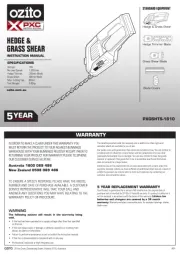
15 Augustus 2025
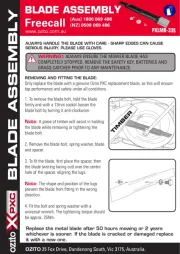
14 Augustus 2025
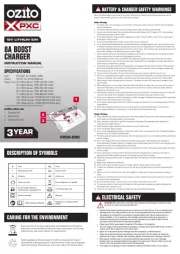
30 Juli 2025
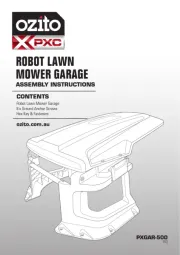
29 Juli 2025
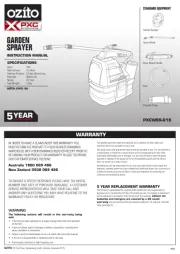
3 Juli 2025
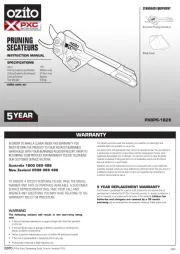
3 Juni 2025

10 December 2024

2 November 2024

8 April 2024

8 April 2024
Handleiding Niet gecategoriseerd
- Bredeco
- Simrad
- Kica
- Levoit
- Crosley
- Veber
- 3Doodler
- Philips
- BOHLT
- Zoll
- Baofeng
- CamRanger
- Innovative
- Aguilar
- Physa
Nieuwste handleidingen voor Niet gecategoriseerd

14 September 2025

14 September 2025

13 September 2025

13 September 2025

13 September 2025

13 September 2025

13 September 2025

13 September 2025

13 September 2025

13 September 2025